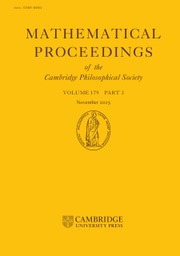The dynamics of the Rikitake dynamo from the stiff limit
Published online by Cambridge University Press: 24 October 2008
Extract
The Rikitake two-disc system [10] has been proposed as a model of the Earth's magnetic dipole. Numerical integration of the system by Rikitake[10] and Allan [1] showed the phenomenon of polarity reversal which is seen in terrestrial paleomagnetic data [6]. Reversals in the simulations occurred at irregular and apparently unpredictable time intervals, in accord with the capricious character of the real data, though the agreement was qualitative rather than quantitative.
- Type
- Research Article
- Information
- Mathematical Proceedings of the Cambridge Philosophical Society , Volume 108 , Issue 1 , July 1990 , pp. 171 - 191
- Copyright
- Copyright © Cambridge Philosophical Society 1990
References
REFERENCES
[1]Allan, D. W.. On the behaviour of systems of coupled dynamos. Proc. Cambridge Philos. Soc. 58 (1962), 671–693.CrossRefGoogle Scholar
[2]Barge, M.. Invariant manifolds and the onset of reversal in the Rikitake two-disk dynamo. SIAM J. Math. Anal. 15 (1984), 514–529.Google Scholar
[3]Bullard, E. C.. Stability of a homopolar dynamo. Proc. Cambridge Philos. Soc. 51 (1955), 744–760.CrossRefGoogle Scholar
[5]Cook, A. E. and Roberts, P. H.. The Rikitake two-disc dynamo system. Proc. Cambridge Philos. Soc. 68 (1970), 547–569.CrossRefGoogle Scholar
[6]Cox, A.. Lengths of geomagnetic polarity intervals. J. Geophys. Res. 73 (1968). 3247–3272.Google Scholar
[7]Erdélyi, A., Magnus, W., Oberwettinger, F. and Tricomi, F. G.Higher Transcendental Functions (McGraw-Hill, 1953).Google Scholar
[8]Hall, G. and Watt, J. M.. Modern Numerical Methods for Ordinary Differential Equations (Clarendon Press, 1978).Google Scholar
[10]Rikitake, T.. Oscillations of a system of disk dynamos. Proc. Cambridge Philos. Soc. 54 (1958), 89–105.CrossRefGoogle Scholar
[11]Sarkovskii, A. N.. Coexistence of cycles of a continuous map of the line into itself. Ukrain. Mat. Zh. 16 (1964), 61–71.Google Scholar
[12]Fowler, A. C. and McGuinness, M. J.. A description of the Lorenz attractor at high Prandtl number. Phys. D 5 (1982), 149–182.Google Scholar
- 1
- Cited by


